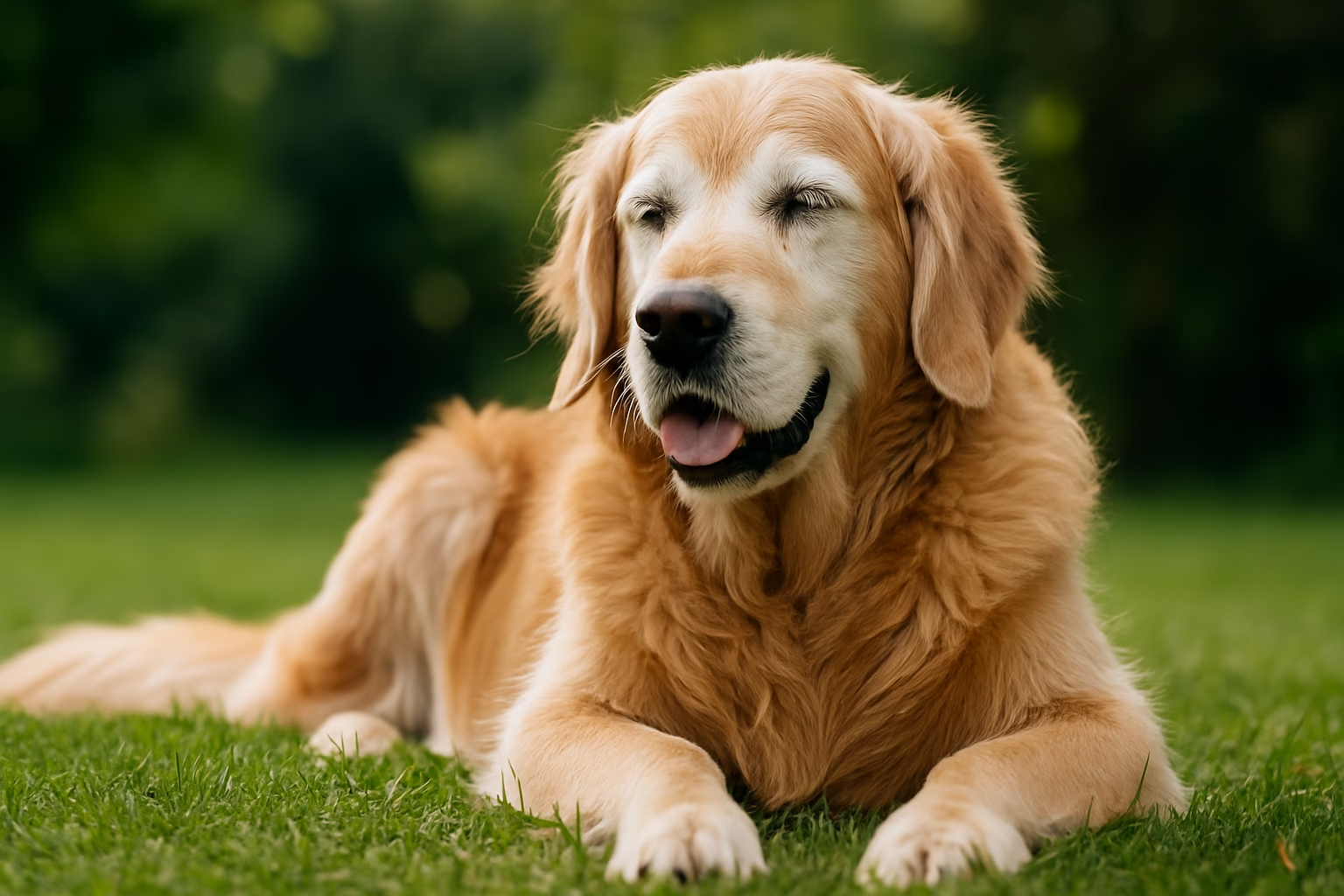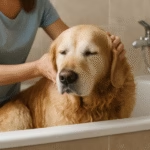I get it — I worry with you when my Golden seems slower. I explain how energy usually shifts as they age and what to expect at 7, 9, 10, and 11 years. I cover why arthritis, joint pain, heart or thyroid issues can cut activity, how to spot true lethargy versus normal aging, what I record before I call the vet, and simple tests I use. I offer safe exercise ideas, a gentle weekly plan, home changes, diet and weight tips, helpful aids, and enrichment games that helped my dog stay happier and more mobile.
Key Takeaway
- My senior Golden rests more but still enjoys short walks.
- I see good days and slow days; both feel normal to me.
- I keep play low-impact and short so my dog feels fine.
- I watch for big drops in energy, since that worries me.
- I talk to my vet when my dog’s activity changes a lot.
Senior Golden Retriever Energy Levels: What’s Normal Over the Years
I’ve watched my Golden slow down like a sunrise that takes longer each day, and I learned to read the new rhythm. The journey of aging matters because small shifts—more naps, shorter sprints, extra sniffing—tell you what your dog needs. I pay attention to how he wakes, how he sits, and how eager he is for play. That habit saved me from missing early arthritis signs; learning to identify the first signs of aging and spot signs of pain made a huge difference.
Over time the bursts of puppy-ish joy soften. He still wags like crazy when I come home, but he’ll pick a sunny spot and guard it like treasure. I focus on preserving strength and joy: short walks that build muscle, soft surfaces for jumping, and puzzle toys for his head. Small changes keep him engaged without wearing him out. For activity ideas I relied on safe, low-impact exercises and mental enrichment activities to keep his mind sharp.
I learned to separate age from pain. Some days are slower because he’s happy to lounge; other days are slower because something hurts. I check mobility, appetite, mood, and sleep. When in doubt, I call the vet—early help changed his comfort and my peace of mind and is part of essential veterinary care for seniors.
Typical activity levels at 7, 9 and 11 years
At 7 years many Goldens are in a transition. They often still enjoy long walks and fetch but need longer warm-ups and more frequent breaks. Shortening routes and adding gentle play at home kept my dog’s spirit up without stressing his joints; the approach follows guidance from creating a healthy routine.
By 9 years the pace changes more clearly. I traded long runs for steady swims, shorter walks, and mental games—scent work and hide-and-seek became big hits. I watched his weight closely; extra pounds slow seniors quickly, so portion control and a tailored diet from senior nutrition guides made a visible difference.
At 11 years walks are shorter, play is gentler, and naps are longer. Consistent, low-impact activity and enrichment keep him comfortable and interested—lot of this aligns with tips on appropriate senior toys and rest routines.
| Age | Typical walk time | Play style | Rest need |
|---|---|---|---|
| 7 | 30–60 minutes | Active fetch, lively | More naps, 12–14 hrs |
| 9 | 20–40 minutes | Short bursts, gentle play, swim | Longer rest, 14–16 hrs |
| 11 | 10–30 minutes | Slow strolls, enrichment toys | Frequent naps, 16 hrs |
How active is a 10-year-old Golden Retriever in real life
When my dog turned 10, I expected a couch potato—but he surprised me. He still loved morning sniff-walks and a brief toss of a soft toy. Recovery changed: after 15 minutes of play he wanted to lie down. I split activity into several short sessions through the day. That kept him moving without tiring him. For ideas to keep him engaged mentally I used nose and puzzle games and easy puzzle feeders and toys.
At 10 you’ll see good days and slow days. Watch for limping, stiffness, or a sudden drop in interest. Low-impact exercise—swimming, gentle walks, slow hill climbs—keeps joints lubricated; hydrotherapy or supervised water play helped my dog recover without stress. Add brain work: scent games, new tricks, and food puzzles that make him think without exhausting him.
Quick checklist for normal activity versus concern
Normal signs:
- Shorter walks, steady appetite, happy greetings, mental interest.
Monitor:
- Stiffness after rest, slower play, more naps — ok if steady.
Concerning signs:
- Sudden decline, limping, loss of appetite, confusion, vocalizing pain — see vet and consult resources on behavioral changes in aging and signs of pain.
Why my senior Golden may lose energy: common medical causes
I noticed my Golden slowing down and at first blamed weather or a busy week. For many older Goldens, medical causes like arthritis, heart disease, hypothyroidism, and chronic pain quietly steal pep. Energy that fades gradually can be normal, but a sudden or deep decline usually signals a problem.
I used observations and then relied on my vet for the map; veterinary exams and tests—bloodwork and X-rays—revealed treatable issues and guided care.
Arthritis, joint pain and age-related mobility issues
My Golden’s hips started creaking like old floorboards. Arthritis and joint wear are common. Gentle exercise, warm beds, and joint supplements helped him move without guarding his legs. Small home adaptations—ramps, non-slip mats, raised bowls—kept him active without forcing painful movements. For focused help see comfort strategies for arthritis and practical tips on mobility solutions.
- Start with short, gentle walks; add ramps, soft bedding, and joint supplements; try hydrotherapy if available.
Heart, thyroid and other health conditions that lower activity levels
When my dog tired after a few minutes of play, I worried about his heart. Heart issues, low thyroid, kidney disease, and infections can all drain energy. My vet listened to his chest, checked blood work, and used scans. Finding the cause allowed targeted treatment and improved daily mood. Learn what vets check during senior visits at essential veterinary care.
Watch for coughing, fast breathing, pale gums, or sudden weight change. Treating his thyroid and adjusting food gave us noticeably better days; see early signs guidance for what to note.
When reduced energy points to illness and needs a vet visit
If your Golden shows sudden collapse, trouble breathing, fainting, severe limping, refusing food for over 24 hours, or rapid weight loss, see a vet fast. Quick action can stop a small problem from becoming a crisis. Trust your gut and follow the checklist many vets recommend in senior care guidelines.
| Condition | Signs I saw | What I did next |
|---|---|---|
| Arthritis / joints | Slower rising, stiffness after rest | Vet exam, NSAIDs, joint supplement, ramps — see arthritis comfort guide |
| Heart disease | Coughing, quick fatigue | Chest X-ray, meds, low-salt diet |
| Hypothyroid | Weight gain, listless | Blood tests, daily thyroid pill (veterinary diagnosis needed) |
| Infection / pain | Fever, hiding, lack of appetite | Vet check, antibiotics or pain relief |
Spotting true lethargy versus normal aging in my dog
There’s a difference between a softer pace and a dog who seems disconnected. I watch whether he perks up for the treat bag, a car pulling in, or a walk. If those spark joy, it’s usually normal aging. If they don’t, dig deeper; resources on behavioral changes helped me set expectations.
I learned to watch patterns, not single days. Senior Golden Retriever Energy Levels: What’s Normal Over the Years is the phrase I use when comparing last month’s behavior to today’s. Small declines are expected; sudden drops or loss of interaction are not.
Signs of low energy in senior Golden Retrievers I watch for
- Struggling to get up, long rests during short walks, or hesitating at stairs.
- Sleep increase but still waking for meals/play is expected; unresponsiveness is a red flag.
- Mood change: loss of greeting enthusiasm, loss of interest in treats.
- Appetite changes, sudden weight loss, or increased drinking.
Distinguishing lethargy from normal aging in dogs with simple tests
I do quick checks at home before panicking:
- Offer a short walk and watch pace, potty stops, and willingness to return.
- Present a favorite toy or treat to check interest.
- Gently flex legs and note any winces.
If you want a structured approach to daily signs and routines, daily comfort routines and sleep guidance are useful references.
| Simple sign | Normal aging pattern | Concerning pattern |
|---|---|---|
| Walking pace | Slower but steady, still willing | Stops frequently, limps, refuses to walk |
| Response to treats/toys | Shows some interest | No interest at all |
| Getting up from rest | Takes a second but stands | Struggles, cries, or can’t stand |
| Appetite | Slight decrease, still eats daily | Refuses food or sudden weight loss |
| Bathroom habits | Same routine, maybe slower | Accidents, straining, or marked changes |
When multiple concerning patterns appear, I don’t wait.
What I record before I call the vet
Before I call, I jot down clear facts so the vet gets a quick picture:
- When the change began and whether it was sudden or gradual
- Appetite, water intake, and any vomiting or diarrhea
- Movement notes: limping, stiffness, trouble rising
- Bathroom details: frequency, accidents, straining
- Any meds, supplements, or new foods given recently
This list helps me feel calmer and speeds up the vet visit. See what vets ask during senior exams to be prepared.
Safe exercise and keeping my older Golden moving
Senior Golden Retriever Energy Levels: What’s Normal Over the Years helped me accept that some days are bouncy and some days are quiet. Keeping him active is about small wins. Short, gentle sessions several times a day beat one long session that tires him out. I mix low-impact play, slow leash walks, and calm sniffing time in the yard. Check joints after activity—if he limps or hesitates, cut back and add rest. For structured routines see safe senior exercises and canine physical therapy options.
Low-impact activities and exercise needs for older Golden Retrievers
Swap hard fetch for gentle retrievals with soft toys and short scent games. Swimming is excellent: it works muscles without stressing joints; learn more about benefits and precautions at hydrotherapy for seniors. If no pool, shallow wading or controlled water play helps. Consistency matters more than intensity—multiple short sessions that match his energy that day.
How to adjust walk length, pace and play for decreased energy
I shortened walks slowly: instead of a 45-minute march, two 15-minute walks plus a sniff session kept him active without draining him. Slow the pace; calm sniff breaks every few minutes help him enjoy the walk. Avoid intense tug or fast-chasing games that jar joints; use soft toys and mental puzzles instead. Guidance on creating a healthy routine helped me plan progressive changes.
A gentle weekly activity plan I can follow
I follow a simple week plan that mixes short walks, water time, and brain games. Mornings: 10–15 minute gentle leash walk. Midday: calm sniff/play or a short training puzzle. Evenings: 15–20 minute relaxed walk or a slow swim if appropriate. Rest days and tweaks as he seems tired.
| Day | Morning | Midday | Evening |
|---|---|---|---|
| Monday | 15 min slow walk | 10 min scent game | 15 min relaxed walk |
| Tuesday | 10 min slow walk | 5 min training puzzle | 20 min gentle swim/yard time |
| Wednesday | 15 min slow walk | 10 min soft play | 15 min relaxed walk |
| Thursday | 10 min slow walk | 5–10 min sniff session | 15 min short walk |
| Friday | 15 min slow walk | 10 min mental game | 15–20 min gentle swim |
| Saturday | 20 min relaxed walk | Rest/short sniff | 15 min calm walk |
| Sunday | Rest or very short stroll | 10 min bonding time | 20 min relaxed walk |
Managing energy and mobility at home for comfort and safety
Senior Golden Retriever Energy Levels: What’s Normal Over the Years varies a lot. I stopped comparing him to his younger self and started noticing small signs: shorter gait, longer rests, need for steadier footing. Comfort at home became a priority: moved rugs, cleared paths, kept food and water near favorite spots, set up a quiet corner with soft bedding and a low ramp. These changes made him calmer and more willing to move; see home adaptations for seniors.
Home changes I made for age-related mobility issues
I moved his bed to the main floor and chose firmer support for his hips. I added non-slip mats where tile made him slide and raised food/water bowls to reduce strain. I kept a ramp by the back door, a night light in the hallway, and boxed fragile items from low shelves. Routine checks of paths and lighting reduced scares and injuries.
- Clear walking paths, add non-slip mats, raise bowls, place ramps, and keep lighting steady. For detailed solutions see mobility practical solutions.
Diet, weight control and supplements for managing energy in aging Golden Retrievers
Food affects mood and movement. Extra pounds made his walks harder and he tired faster. I switched to a lower-calorie senior formula with good protein and fiber; the senior nutrition guide helped me pick a balanced option. Small, frequent meals helped digestion and steadier energy.
Supplements helped too. I added fish oil (omega-3) and glucosamine after vet discussion. Changes weren’t instant, but over weeks he moved with less stiffness. I tracked weight and energy weekly to tweak portions or treats quickly. See recommended supplements for more.
| Item | Why I used it | Notes |
|---|---|---|
| Senior kibble (lower calories, higher protein) | Keeps weight steady and muscles strong | Adjust portions by weight check every 2–4 weeks; see weight maintenance tips |
| Fish oil (omega-3) | Reduces inflammation, supports coat and joints | Use vet-recommended dose; mix into food |
| Glucosamine chondroitin | Helps joint comfort and cartilage support | Works over weeks; monitor for digestion issues |
Simple tools and aids that helped my dog move more
A harness with a handle saved us on stairs and wobbly steps; a soft ramp let him reach favorite spots without jumping. A low-sided bed eased entry and washable rugs gave grip on slick floors. These small tools improved confidence and mobility — details on helpful aids are in home adaptation tips and mobility solutions.
Enrichment, mental stimulation and real tips from my experience with my senior Golden
I watched my Golden slow down and then light up again when I changed small things. Mental work often wakes up energy gently. Senior Golden Retriever Energy Levels: What’s Normal Over the Years can include bright, playful moments even as physical speed drops. I used mental enrichment activities, rotated toys from appropriate toy lists, and focused on bonding with bond-building activities.
Mix short activities with long rest. When bored, a new scent game or stuffed toy sparked interest without tiring him. Little changes—softer beds, non-slip rugs, treats hidden at ground level—kept him curious and engaged. Let him lead the pace.
Games and puzzles that boosted my senior Golden Retriever energy levels
Scent-based games (hide a treat under a towel or around a room) use nose and brain and give satisfaction. Puzzle feeders and slow-dispense toys provide calm challenges. Keep difficulty low so he wins often and stays confident. Sessions of 5–12 minutes a few times a day were ideal.
| Game / Puzzle | What it does | Ideal session length | Caution for seniors |
|---|---|---|---|
| Scent hide-and-seek | Uses brain & nose | 5–10 minutes | Avoid long searches if breathing hard |
| Puzzle feeder | Slow eating & problem solving | 5–12 minutes | Start easy to prevent frustration |
| Gentle tug / soft fetch | Light muscle use, joy | 5–8 minutes | Skip quick, sharp pulls; watch joints |
| Short swim or water play | Low-impact movement | 10–20 minutes | Supervise; use ramp or steps for entry |
For more puzzle ideas and toys, see toy recommendations and enrichment activities.
How I balanced rest and activity to support normal activity levels in an older Golden Retriever
I learned to read his signals. If he stretched and brightened after a nap, I offered a short walk. If he yawned and moved slowly, we stayed home with a puzzle. Flexibility beat a rigid plan. Two or three short walks beat one long march. Regular vet check-ups guided when to cut back or try a new gentle game; checklists in senior vet care are helpful.
Caregiver tips I rely on when energy dips
- Offer short, easy games multiple times a day rather than long sessions.
- Use ramps and rugs to protect joints and encourage movement; see home adaptation tips.
- Rotate toys to keep novelty without overload; consult age-appropriate toys.
- Keep hydration and body temperature steady—watch for heat or cold sensitivity.
- Track energy and bathroom habits; mention changes to your vet and follow daily comfort routines.
Conclusion
I’ve learned that my Golden’s slowing is often a soft sunset, not an emergency. I watch shifts in energy, note new stiffness, and trust my gut. When something feels off—sudden limp, loss of appetite, or a blank stare—I call the vet. Early checks and simple tests have saved us worry more than once.
Small changes made the biggest difference: short, gentle walks, low‑impact play, swims, puzzle games, ramps, non‑slip rugs, a firmer bed, portion control to manage weight, and joint supplements after vet advice. Mental enrichment lit him up on quiet days. Consistent routine and quick adjustments kept him comfortable and confident.
For practical guides and real-life experiences, I often reread resources like real stories of senior Goldens, the early signs checklist, and detailed pages on senior nutrition and safe exercises. Your dog is the best teacher—listen, act early, and adapt.

Rafael Souza is a digital marketing strategist and lifelong dog enthusiast. Passionate about Golden Retrievers, he shares practical, research-based tips to help owners provide healthier and happier lives for their furry companions.





